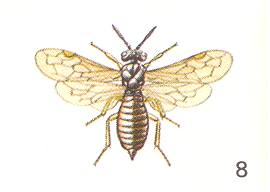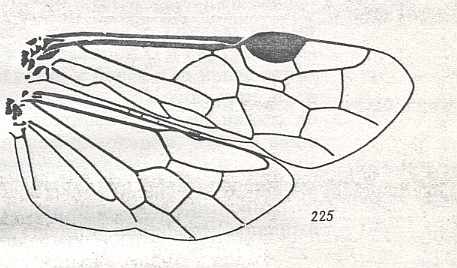Blasticotomidae
The Blasticotomidae are a family of sawflies, which is bound to ferns. Worldwide twelve species are known.
Features
The adults are about 5 to 10 mm long and brown to black in color, often with yellowish legs. Peculiar is the construction of the short probe having only three or four members, whose third member, created from the merger of almost all members scourge, is greatly extended. In the genus Blasticotoma sits above them still a tiny fourth member at that either completely missing the other genera, or is so greatly reduced that it is easily overlooked. Other features include pedunculated and pear-shaped first Diskoidalzelle, the large and semicircular Flügelmal ( pterostigma ) in the wings. The front legs have two Apikaldorne whose inner is bicuspid.
Larvae
The larva is described in the European style Blasticotoma filiceti. It is greenish - white, with light brown to reddish-brown head capsule and in the last stage about 11 mm long. It has five-membered antennas. On thorax sit three pairs of legs, while Abdominalbeine completely absent. Very striking and unmistakably are two fairly long, ear- like appendages above ( dorsal) on the eighth and ninth abdominal segment. The larva lives minierend in the leaf stems of ferns. Their presence shows itself, in addition to discoloration and stunting the subsequent spreading, usually on a foam-like secretion bales (similar to the froghoppers ), but which is easily washed off by rain.
In Farnstängeln other discriminatory sawfly larvae occur ( an overview can be found at Jan Macek (2010). ), But these do not Dorsalanhänge.
Way of life
As far as known, are all ways of Blasticotomidae leaf miners in the larval stage in different fern species. Here are several, not necessarily more closely related species of ferns occupied by the species better known. The female pierces the egg with its ovipositor individually or collectively in the stem a. The ausschlüpfende larva eats a cavity in the stem, which remains very short and hardly exceeds the length of the larva. The actual nutrition via the cavity exiting plant juices. This type of diet, by liquid diet with chewing mouthparts, is highly unusual in insects. If several larvae occupy a stem, eating any of them in its own, completely separate from the other cavity. The flight time of the imagines and oviposition is in European style in the plains in May, one to two weeks after sprouting of the fronds ( in the Alps at the end of June 1400 to 1600 m ), the larva approximately 6 weeks after the imagos on the plant detectable. It occurs both in this and in the other species, as far as known, only one generation a year. The Central European species seems to reproduce by parthenogenesis, or at least could at a site where the species was observed over ten years regularly five to over 30 Imagines throughout the flight period, never ♂ ♂ be determined.
Only a few years ago has been discovered that the statements made by the larva secretions are regularly picked up by ants that enter into a close bond ( trophobiosis ) with this as it was unknown until then almost only detected by plant lice in other Hymenoptera.
Dissemination
With one exception, all species live in the northern East Asia, China, Korea and Japan, south to Taiwan. The type Blasticotoma filiceti is spread across the whole of northern Asia and northern Europe, but is very rarely found, so that almost any Fund will be published immediately. An overview of the European distribution, as far as known, are Wolfgang Schedl (1973).
Fossil only one type has been found. The Miocene species comes from the fossil site of Florissant in North America where no extant species of the family occurs more and Paremphytus ostentatus was named.
System
The Blasticotomidae among the Tenthredinoidea, which include the rights sawflies ( Tenthredinidae ) and some related families. They may form the sister group of all other families. This position is not always supported by recent analyzes.
The systematics within the family is somewhat confused. In addition to the genus Blasticotoma exist one or two other genera. The second species was later synonymized Runaria with the fossil genus Paremphytus, whereupon the recent species were transferred to this genus. Later, the synonymy was lifted and the species transferred back, but this was not mitvollzogen of all reviewers. The third genus Bohea (not all ) synonymized by some editors with Runaria. This results in a confusion in the naming, which obscures the relationships.
The systematics of the family can then look like this:
- Genus Basticotoma Blasticotoma filiceti Klug, 1834; Palaearctic
- Blasticotoma atra Zhelokhovzev, 1934; Japan, the Russian Far East, on bracken
- Blasticotoma nipponica Takeuchi, 1939; Japan
- Blasticotoma smithi Shinohara, 1983; Taiwan
- Blasticotoma warabii Togashi, 1989; Japan
- Genus Runaria Runaria flavipes Takeuchi, 1939; Japan, tripteron to erythroscia Dryopteris, Athyrium japonica and Polystichum
- Runaria reducta Malaise, 1931; Japan, on bracken
- Runaria shaanxinica Wei, 1999; China
- Runaria hunannica Wei, 1999; China
- Runaria punctata Wei, 1999; China
- Genus Bohea Bohea abrupta Maa, 1944; China ( Fukien )








